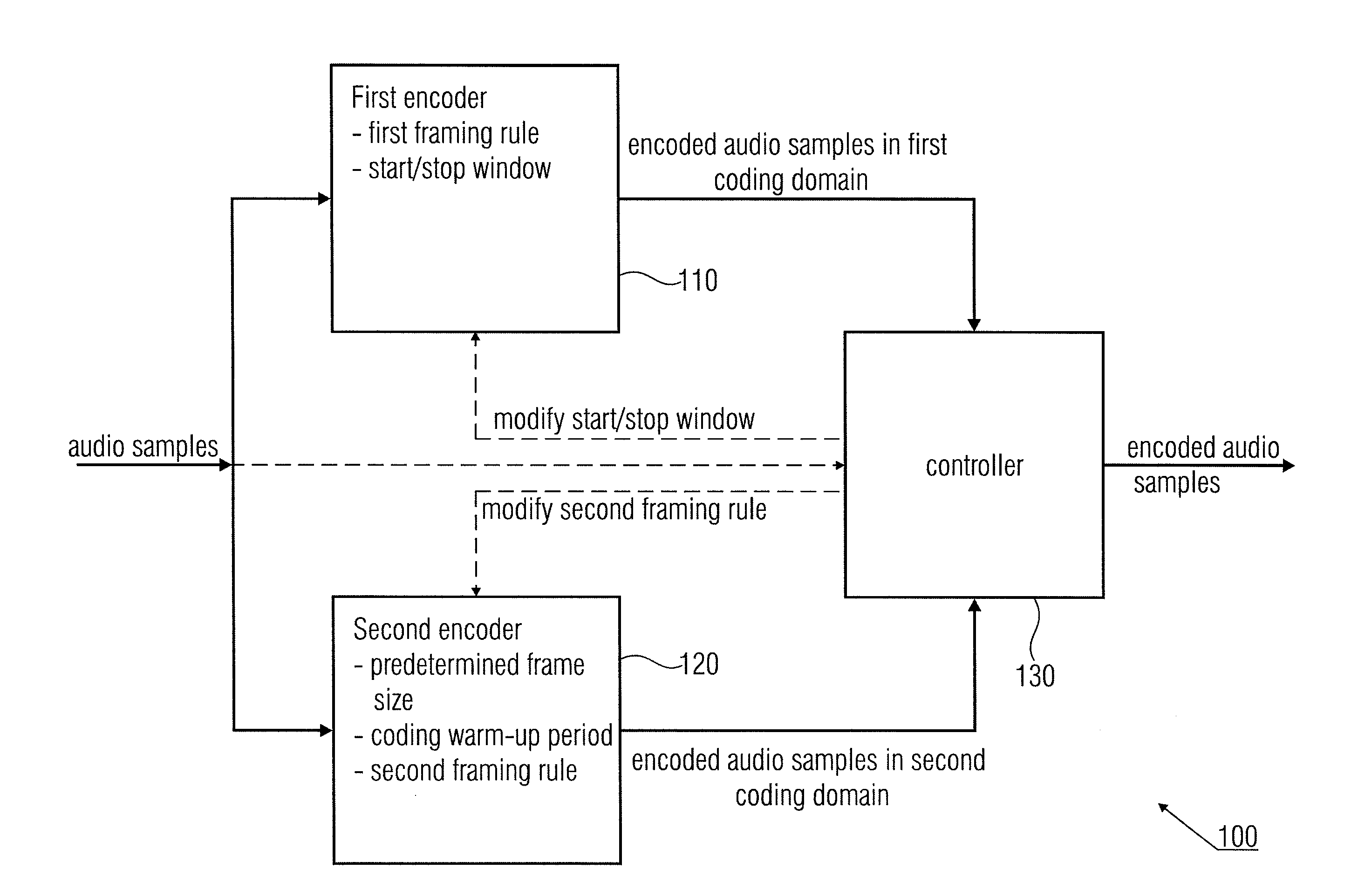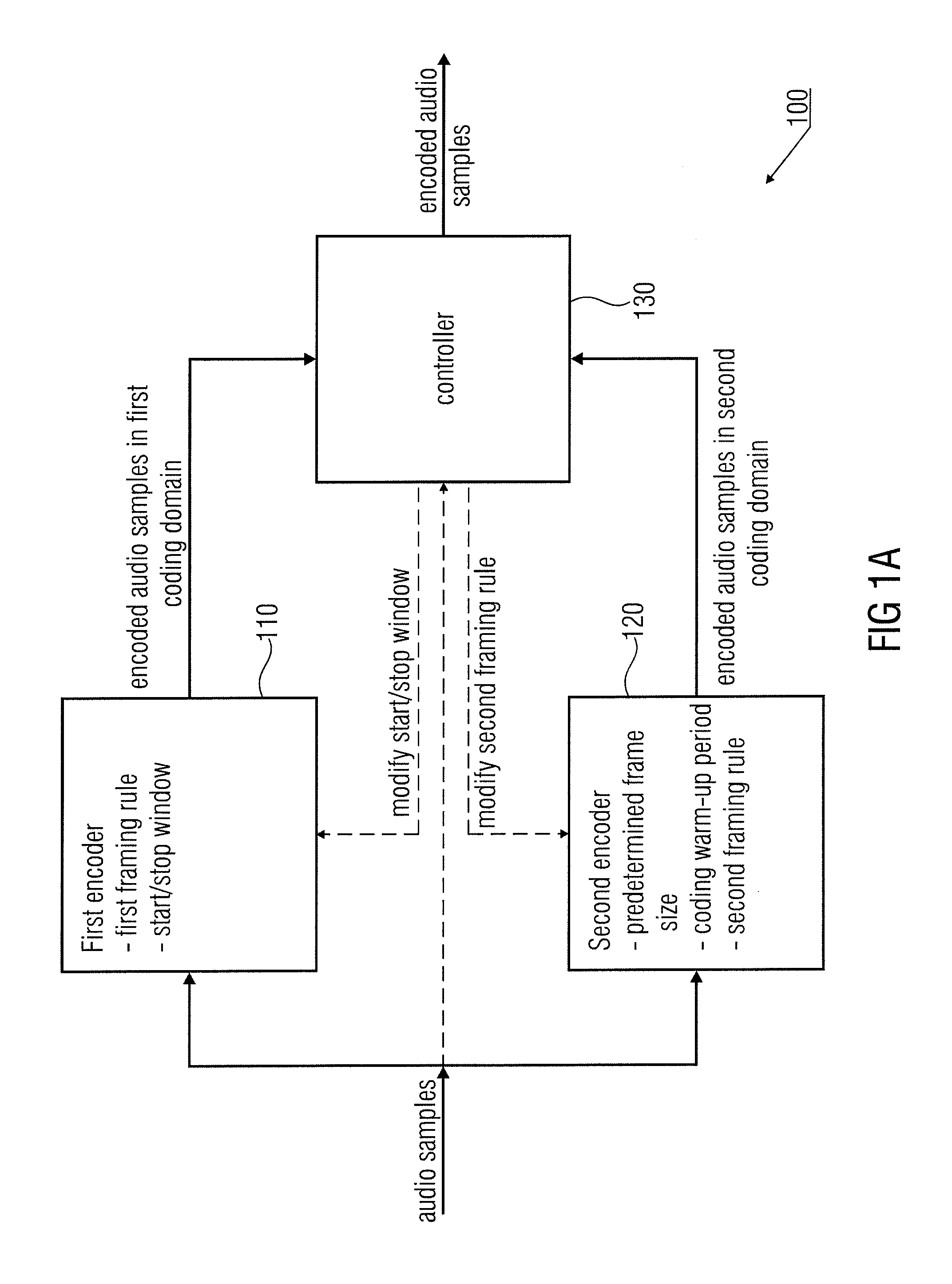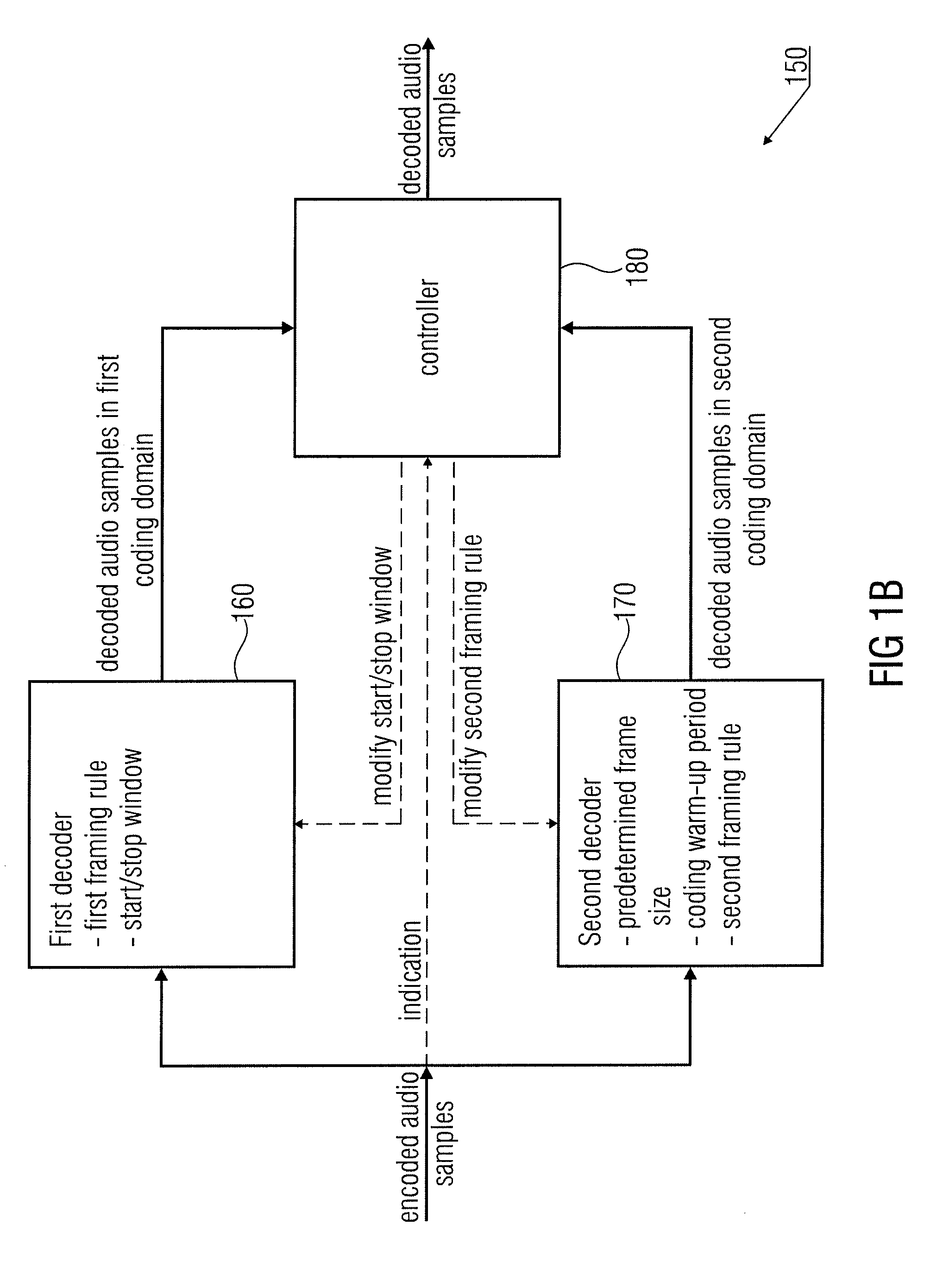According to another embodiment, an audio encoder for encoding audio samples may have: a first
time domain aliasing introducing encoder for encoding audio samples in a first encoding domain, the first time domain
aliasing introducing encoder having a first framing rule, a start window and a stop window; a second encoder for encoding samples in a second encoding domain, the second encoder having a different second framing rule and having an AMR or AMR-WB+ encoder with the second framing rule being an AMR framing rule according to which a
superframe has four AMR frames, the second encoder having a predetermined
frame size number of audio samples for the
superframe, and a coding warm-up period number of audio samples, a
superframe of the second encoder being an encoded representation of a number of timely subsequent audio samples, the number being equal to the predetermined frame size number of audio samples; and a controller for switching from the first encoder to the second encoder or vice versa in response to a characteristic of the audio samples, and for modifying the second framing rule in response to switching from the first encoder to the second encoder or from the second encoder to the first encoder to the extent that a first superframe at the switching has an increased frame size number of audio samples with having a fifth AMR frame in addition to the four AMR frames, with the fifth AMR frame respectively overlapping a
fading part of a start window or a stop window of the first time domain aliasing introducing encoder.
According to another embodiment, a method for encoding audio frames may have the steps of: encoding audio samples in a first encoding domain using a first framing rule, a start window and a stop window; encoding audio samples in a second encoding domain using a different second framing rule by way of AMR or AMR-WB+ encoding with the second framing rule being an AMR framing rule according to which a superframe has four AMR frames, and using a predetermined frame size number of audio samples for the superframe, the superframe of the second encoding domain being an encoded representation of a number of timely subsequent audio samples, the number being equal to the predetermined frame size number of audio samples; switching from the first encoding domain to the second encoding domain or vice versa; and modifying the second framing rule in response to switching from the first to the second encoding domain or from the second encoder to the first encoder to the extent that a first superframe at the switching has an increased frame size number of audio samples with having a fifth AMR frame in addition to the four AMR frames, with the fifth AMR frame respectively overlapping a
fading part of a start window or a stop window of the first time domain aliasing introducing encoder.
According to another embodiment, an audio decoder for decoding encoded frames of audio samples may have: a first time domain aliasing introducing decoder for decoding audio samples in a first decoding domain, the first time domain aliasing introducing decoder having a first framing rule, a start window and a stop window, the first decoder having a time domain
transformer for transforming a first frame of decoded audio samples to the time domain based on an inverse modified
discrete cosine transformation (IMDCT); a second decoder for decoding audio samples in a second decoding domain, the second encoder having a different second framing rule and having an AMR or AMR-WB+ encoder with the second framing rule being an AMR framing rule according to which a superframe has four AMR frames, and the second decoder having a predetermined frame size number of audio samples for the superframe and a coding warm-up period number of audio samples, a superframe of the second encoder being an encoded representation of a number of timely subsequent audio samples, the number being equal to the predetermined frame size number of audio samples; and a controller for switching from the first decoder to the second decoder or vice versa based on an indication in the encoded frame of audio samples, wherein the controller is adapted for modifying the second framing rule in response to switching from the first decoder to the second decoder or from the second encoder to the first encoder to the extent that a first superframe at the switching has an increased frame size number of audio samples with having a fifth AMR frame in addition to the four AMR frames, with the fifth AMR frame respectively overlapping a
fading part of a start window or a stop window of the first time domain aliasing introducing encoder.
According to another embodiment, a method for decoding encoded frames of audio samples may have the steps of: decoding audio samples in a first decoding domain, the first decoding domain introducing time aliasing, having a first framing rule, a start window and a stop window, and using transforming a first frame of decoded audio samples to the time domain based on an inverse modified
discrete cosine transformation (IMDCT); decoding audio samples in a second decoding domain unsing a different second framing rule by AMR or AMR-WB+ encoding with the second framing rule being an AMR framing rule according to which a superframe has four AMR frames, the second decoding domain having a predetermined frame size number of audio samples and a coding warm-up period number of audio samples, a superframe of the second decoding domain being a decoded representation of a number of timely subsequent audio samples, the number being equal to the predetermined frame size number of audio samples; and switching from the first decoding domain to the second decoding domain or vice versa based on an indication from the encoded frame of audio samples; modifying the second framing rule in response to switching from the first coding domain to the second coding domain or from the second encoder to the first encoder to the extent that a first superframe at the switching has an increased frame size number of audio samples with having a fifth AMR frame in addition to the four AMR frames, with the fifth AMR frame respectively overlapping a fading part of a start window or a stop window of the first time domain aliasing introducing encoder.
It is a finding of the present invention that an improved switching in an audio coding concept utilizing time domain and
frequency domain encoding can be achieved, when the framing of the corresponding coding domains is adapted or modified cross-fade windows are utilized. In one embodiment, for example AMR-WB+ can be used as time domain codec and AAC can be utilized as an example of a frequency-domain codec, more efficient switching between the two codecs can be achieved by embodiments, by either adapting the framing of the AMR-WB+ part or by using modified start or stop windows for the respective AAC coding part.
Embodiments of the present invention may provide the
advantage that
overhead information can be reduced, introduced in overlap transition, while keeping moderate cross-fade regions assuring cross-fade quality.
 Login to View More
Login to View More  Login to View More
Login to View More 


